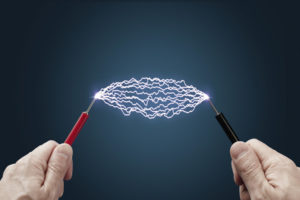Fundamental Differences
Alternating current (AC) and direct current (DC) refer to how electrons flow through a conductor. As the names suggest, in AC the direction  of electrons alternate frequently, but in DC the electrons flow in only one direction. In reality, both AC and DC are flow of electrons, but they differ the way they flow. The differences in this flow stem from the way AC and DC are produced. AC is produced by rotating magnet along wire while DC is produced with steady magnetism. That’s why in a graph the AC looks like a sine curve, but the DC is a straight line. A common example of AC is the power we get from the power companies. On the other hand, an example of DC would be the power supplied by an alkaline battery.
of electrons alternate frequently, but in DC the electrons flow in only one direction. In reality, both AC and DC are flow of electrons, but they differ the way they flow. The differences in this flow stem from the way AC and DC are produced. AC is produced by rotating magnet along wire while DC is produced with steady magnetism. That’s why in a graph the AC looks like a sine curve, but the DC is a straight line. A common example of AC is the power we get from the power companies. On the other hand, an example of DC would be the power supplied by an alkaline battery.
Differences in Their Usage
Equipment such as flashlight that uses batteries are essentially using DC power. On the other hand, the lights in our houses use AC power. Many devices use both AC and DC. For example, a laptop uses both AC and DC power. It receives AC from the electrical outlet on the wall. Then it converts this AC power to DC by the power adapter, and receives that DC power to run the laptop. In the United States AC supplied to homes is 120 volts at 60 Hz, meaning they oscillate 60 times per second. For more info visit the electrician north shore website.
Performance Differences
The reason AC is so prevalent is that it’s much more economic to produce than DC power. Another big factor that made AC popular is the efficiency with which it can be transmitted over long distances. Such is not the case with DC power. DC power very quickly loses strength with distance. The strength of AC can also be easily regulated by transformers.
Future of AC and DC Power
Thomas Edison is credited with advocating DC power, but Nikola Tesla is often cited as the originator of AC power. Though AC power has reigned as the most used electric power, DC is having a comeback in recent years with the advent of solar cells and electric cars. In modern day, there is no rivalry between these two forms of electric power. In most cases they work hand in hand to serve us better.